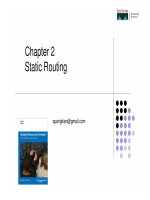Routing Protocols and Concepts: Chapter 2 pot
Bạn đang xem bản rút gọn của tài liệu. Xem và tải ngay bản đầy đủ của tài liệu tại đây (1.64 MB, 110 trang )
Chapter 2
Static Routing
22
Topics
l Routers and the Network
Ÿ Role of the Router
Ÿ Introducing the Topology
Ÿ Examining the Connections of
the Router
l Router Configuration Review
Ÿ Examining Router Interfaces
Ÿ Configuring an Ethernet
Interface
Ÿ Verifying Ethernet Addresses
Ÿ Configuring a Serial Interfaces
Ÿ Examining Serial Interfaces
l Exploring Directly Connected
Networks
Ÿ Verifying Changes to the
Routing Table
Ÿ Devices on Directly Connected
Networks
Ÿ Cisco Discovery Protocol (CDP)
Ÿ Using CDP for Network
Discovery
l Static Routes - Next-Hop Addresses
Ÿ ip route command
Ÿ Configuring Static Routes
Ÿ Routing Table Principles
Ÿ Resolving to an Exit Interface with
a Recursive Lookup
l Static Routes - Exit Interfaces
Ÿ Configuring a Static Route with an
Exit Interfaces
Ÿ Static Routes and Point-to-Point
Networks
Ÿ Modifying Static Routes
Ÿ Verifying the Static Route
Configuration
Ÿ Static Routes - Ethernet Interface
l Summary and Default Static Routes
Ÿ Summary Static Routes
Ÿ Default Static Routes
l Managing and Troubleshooting Static
Routes
Ÿ Static Routes and Packet
Forwarding
Ÿ Troubleshooting a Missing Route
Ÿ Solving the Missing Route
Routers and the Network
l Role of the Router
l Introducing the Topology
l Examining the Connection on the Router
44
Role of the Router
l Routers are primarily responsible for interconnecting networks by:
Ÿ Determining the best path
Ÿ Forwarding packets
55
Topology
l A Cisco 1841 router has the following interfaces:
Ÿ Two Fast Ethernet interfaces: FastEthernet 0/0 and FastEthernet 0/1
Ÿ Two serial interfaces: Serial 0/0/0 and Serial0/0/1
l The interfaces on your routers can vary.
l Packet Tracer Activities are referenced throughout these chapters for
additional practices.
Introducing the
Topology
66
Examining the Connections
l Unlike most user PCs, a router will have multiple network interfaces.
l These interfaces can include a variety of connectors.
77
Serial Connectors
l Cisco routers support the EIA/TIA-232, EIA/TIA-449, V.35, X.21, and
EIA/TIA-530 standards for serial connections,
l Memorizing these connection types is not important.
l Just know that a router has a DB-60 port that can support five different
cabling standards.
88
Serial Connectors
l 2500 have the “older,” larger serial interfaces
l Later Cisco routers use the smart serial interfaces which allows
more data to be forwarded across fewer cable pins.
Smart
Serial
“Older”
Serial
99
Serial Connectors
l Router is typically a DTE device.
l The DTE cable is connected to the serial interface on the router to a
CSU/DSU device (DCE).
DTE Cable
DCE Cable
1010
Serial Connectors
l In our labs we will use serial DTE/DCE cables (no CSU/DSU) with a
DTE cable connected to one router and a DCE cable connected to
the other router.
DTE
DCE
DTE DTE
1111
Ethernet Connectors
l Straight-through cables
are used for:
Ÿ Switch-to-router
Ÿ Hub-to-router
Ÿ Switch-to-PC/server
Ÿ Hub-to-PC/server
l Crossover cables are used for:
Ÿ Switch-to-switch
Ÿ PC/server-to-PC/server
Ÿ Switch-to-hub
Ÿ Hub-to-hub
Ÿ Router-to-router
Ÿ Router-to-PC/server
Router Configuration Review
l Examining Router Interfaces
l Configuring an Ethernet Interface
l Verifying Ethernet Addresses
l Configuring a Serial Interfaces
l Examining Serial Interfaces
1313
Examining Router Interfaces
l show ip route command is used to display the routing table.
l Initially, the routing table is empty if no interfaces have been
configured.
l Note: Static routes and dynamic routes cannot be added to the
routing table until the appropriate local interfaces, also known as the
exit interfaces, have been configured on the router. (later)
R1# show ip route
Codes: C - connected, S - static, I - IGRP, R - RIP, M - mobile, B - BGP
D - EIGRP, EX - EIGRP external, O - OSPF, IA - OSPF inter area
N1 - OSPF NSSA external type 1, N2 - OSPF NSSA external type 2
E1 - OSPF external type 1, E2 - OSPF external type 2, E - EGP
i - IS-IS, L1 - IS-IS level-1, L2 - IS-IS level-2, ia - IS-IS inter area
* - candidate default, U - per-user static route, o - ODR
P - periodic downloaded static route
Gateway of last resort is not set
R1#
1414
Interfaces and their Statuses
R1# show interfaces
FastEthernet0/0 is administratively down, line protocol is down
Hardware is AmdFE, address is 000c.3010.9260 (bia
000c.3010.9260)
<output omitted>
Serial0/0/0 is administratively down, line protocol is down
<output omitted>
1515
Interfaces and their Statuses
l Used to see a portion of the interface information in a condensed
format
l Note: Great command for checking interfaces before starting a
lab!
R1# show ip interface brief
Interface IP-Address OK? Method Status Protocol
FastEthernet0/0 unassigned YES manual administratively down down
Serial0/0 unassigned YES unset administratively down down
FastEthernet0/1 unassigned YES unset administratively down down
Serial0/1 unassigned YES unset administratively down down
R1#
1616
Interfaces and their Statuses
l show running-config command displays current configuration file
l another way to verify the configuration of an interface
R1# show running-config
<output omitted>
interface FastEthernet0/0
mac-address 000c.3010.9260
no ip address
duplex auto
speed auto
shutdown
!
interface FastEthernet0/1
mac-address 000c.3010.9261
no ip address
duplex auto
speed auto
shutdown
<output omitted>
1717
Configuring an Ethernet Interface
l changed state to up message indicates that, physically, the connection is
good.
Ÿ interface is properly connected to a switch or a hub.
Ÿ receiving a carrier signal from another device (switch, hub, PC, or
another router).
l changed state to up message indicates that the data link layer is
operational.
Ÿ LAN interfaces, typically no data link parameter changes.
Ÿ WAN interfaces in a lab environment require clocking on one side of
the link
R1(config)# interface fastethernet 0/0
R1(config-if)# ip address 172.16.3.1 255.255.255.0
R1(config-if)# no shutdown
*Mar 1 01:16:08.212: %LINK-3-UPDOWN: Interface FastEthernet0/0,
changed state to up
*Mar 1 01:16:09.214: %LINEPROTO-5-UPDOWN: Line protocol on Interface
FastEthernet0/0, changed state to up
1818
Unsolicited Messages from IOS
l The IOS often sends unsolicited messages
Ÿ Does not affect the command
Ÿ Can cause you to lose your place when typing.
R1(config)# int fa0/0
R1(config-if)# ip address 172.16.3.1 255.255.255.0
R1(config-if)# no shutdown
R1(config-if)# descri
*Mar 1 01:16:08.212: %LINK-3-UPDOWN: Interface
FastEthernet0/0, changed state to up
*Mar 1 01:16:09.214: %LINEPROTO-5-UPDOWN: Line protocol on
Interface
FastEthernet0/0, changed state to upption
R1(config-if)#
1919
Unsolicited Messages from IOS
l To keep the unsolicited output separate from your input, enter line
configuration mode for the console port and add the logging
synchronous
R1(config)# line console 0
R1(config-line)# logging synchronous
R1(config-if)# descri
*Mar 1 01:28:04.242: %LINK-3-UPDOWN: Interface
FastEthernet0/0, changed state to up
*Mar 1 01:28:05.243: %LINEPROTO-5-UPDOWN: Line protocol on
Interface
FastEthernet0/0, changed state to up
R1(config-if)# description
2020
Reading the Routing Table
l The interface was configured with the 172.16.3.1/24 IP address,
which makes it a member of the 172.16.3.0/24 network.
l C = directly connected
Ÿ R1 has an interface that belongs to this network
l The /24 subnet mask for this route is displayed in the line above the
actual route.
R1# show ip route
Codes: C - connected, S - static, I - IGRP, R - RIP, M -
mobile, B - BGP
<output omitted>
Gateway of last resort is not set
172.16.0.0/24 is subnetted, 1 subnets
C 172.16.3.0 is directly connected, FastEthernet0/0
2121
Routers Usually Store Network Addresses
l Phone book analogy: Families not individuals with same number
l Occasionally, a “host route” is entered in the routing table; the host
route represents an individual host IP address.
l The host route is listed with the device’s host IP address and a /32
(255.255.255.255) subnet mask.
l The topic of host routes is discussed in another course.
R1# show ip route
Codes: C - connected, S - static, I - IGRP, R - RIP, M -
mobile, B - BGP
<output omitted>
Gateway of last resort is not set
172.16.0.0/24 is subnetted, 1 subnets
C 172.16.3.0 is directly connected, FastEthernet0/0
2222
Commands to Verify Interface Configuration
R1# show interfaces fastethernet 0/0
FastEthernet0/0 is up, line protocol is up
Hardware is AmdFE, address is 000c.3010.9260 (bia 000c.3010.9260)
Internet address is 172.16.3.1/24
<output omitted>
R1# show ip interface brief
Interface IP-Address OK? Method Status Protocol
FastEthernet0/0 172.16.3.1 YES manual up up
Serial0/0/0 unassigned YES unset administratively down down
FastEthernet0/1 unassigned YES unset administratively down down
Serial0/0/1 unassigned YES unset administratively down down
R1# show running-config
<output omitted>
interface FastEthernet0/0
ip address 172.16.3.1 255.255.255.0
<output omitted> Note: no shutdown is not displayed.
2323
Ethernet Interfaces Participate in ARP
l A router’s Ethernet interface participates in a LAN network just like any
other device on that network.
l This means that these interfaces:
Ÿ Layer 2 MAC address
Ÿ ARP Cache
Ÿ Issue ARP Requests when needed
Ÿ Issue ARP Replies when required
R1# show interfaces fastethernet 0/0
FastEthernet0/0 is up, line protocol is up
Hardware is AmdFE, address is 000c.3010.9260 (bia
000c.3010.9260)
Internet address is 172.16.3.1/24
<output omitted>
2424
Configuring a Serial Interface
l The serial interface will be in the up state only after the other end of the
serial link has also been properly configured.
R1(config)# interface serial 0/0/0
R1(config-if)# ip address 172.16.2.1 255.255.255.0
R1(config-if)# no shutdown
R1# show interfaces serial 0/0/0
Serial0/0/0 is down, line protocol is down
Hardware is PowerQUICC Serial
Internet address is 172.16.2.1/24
MTU 1500 bytes, BW 1544 Kbit, DLY 20000 usec,
<output omitted>
2525
Configuring a Serial Interface
l Both interfaces do NOT have to be the same (Serial 0/0/0).
l Both interfaces do have to be members of the same network
Ÿ Same 172.16.2.0/24 network.
l (The terms network and subnet can be used interchangeably in this
case.)
R1(config)# interface serial 0/0/0
R1(config-if)# ip address 172.16.2.1 255.255.255.0
R1(config-if)# no shutdown
R2(config)# interface serial 0/0/0
R2(config-if)# ip address 172.16.2.2 255.255.255.0
R2(config-if)# no shutdown
Can be
different
Must be
hosts on
same
network









